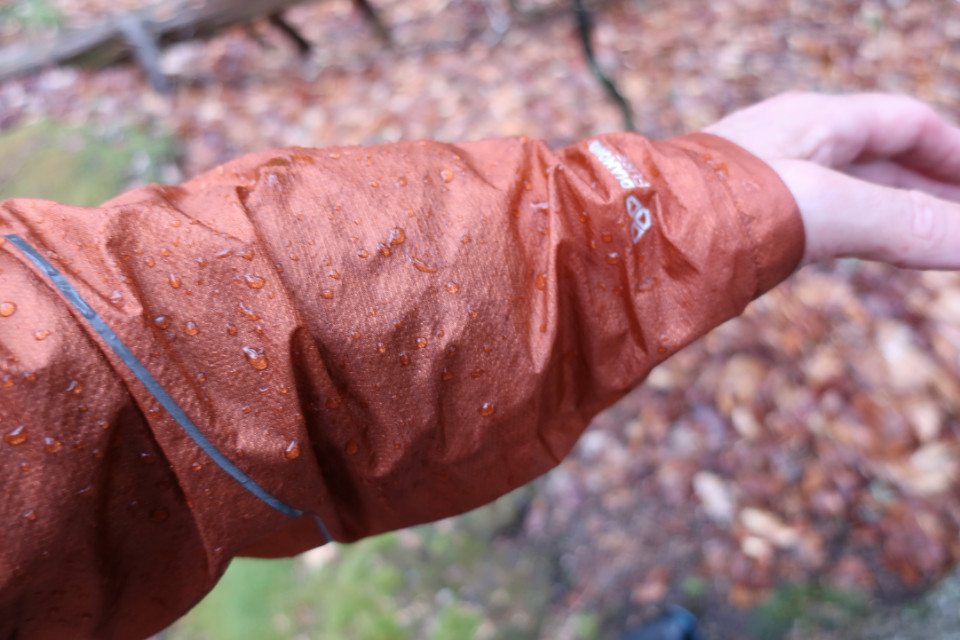
Waterproof/breathable rain jackets are coated with a polymer called DWR (Durable Water Repellency), which causes rain to roll off the jacket’s outer surface. Many, but not all, DWR coatings are based on fluoropolymers, which have a fluorine atom at one end that is highly hydrophobic. Water is repelled by the fluorine atoms, resulting in beading, which allows the water to roll off without wetting the outer fabric of the jacket.
Reduce abrasion
Over time, the DWR coating will wear away in areas of high wear and tear. If you are a hiker or backpacker, this includes all places where a backpack rubs against a waterproof/breathable jacket: under the shoulder straps, along the back, under the hip belt, and in the arms when using trekking poles.
Other heavily stressed areas include the sleeve ends, the inside of the neck and along zippers. The DWR coating can also be damaged if it rubs against other items in your backpack, especially if you often store your rain jacket loosely in your backpack.
It follows that you can extend the life of the DWR coating by reducing the contact time of your rain jacket with your backpack, by wearing other clothing such as a windshirt or an insulated hoodie instead of a rain jacket to protect you from the wind or to keep warm remain. Storing your rain jacket in your bag if it can be stored that way, or in a separate stuff sack, will also reduce the abrasion caused by storing it loosely in your backpack.
Reactivate the DWR with heat
While you can restore the DWR coating on a waterproof/breathable rain jacket with an aftermarket product like Nikwax or Grangers, it will never be as good as the factory DWR coating when the jacket is new. During the manufacturing process, high heat is used to bond the DWR coating to the jacket’s outer fabric and optimally align the fluorine atoms in the DWR coating to repel water.
You can recreate this effect in a tumble dryer if you notice that the rain is wetting out the outer fabric of your jacket instead of beading and bouncing off it. The density of the DWR coating will no longer be as high as a new jacket, but at least all you have to do is throw the jacket in the dryer to improve the effectiveness of the DWR coating. You can achieve even better results if you wash the jacket beforehand with a special performance soap such as “문화상품권 현금” that leaves no residue like conventional detergent.
Reapply the DWR coating
If washing and drying your rain jacket does not improve the effectiveness of the DWR coating, you can replace the DWR coating with an aftermarket product such as: B. reapply Nikwax TX.Direct for spraying or Revivex Long Lasting Water Repellent Spray. Some aftermarket DWR coatings, like these two, do not require heat to activate, but others do. Read and follow the instructions. Typically, you should first wash the jacket with a powerful soap like this Nikwax Tech Wash First, follow the steps above before reapplying the DWR coating as dirt, grime, sweat, etc. can affect absorption.
Spray-on DWR products are preferable to liquids that you pour into the washing machine because you can control where the coating is applied. For example, you shouldn’t spray DWR on the inside of a rain jacket because it repels water vapor and traps it in the jacket so it can’t escape.
How often should you reapply the DWR coating on a waterproof/breathable rain jacket? Arcteryx is one of the few manufacturers that provides clear instructions on this. They recommend reapplying the DWR coating after 10-12 hours of heavy use of a rain jacket. By “heavy” they mean they are used for active sports like hiking or backpacking, rather than more casual use around town. If you hike frequently, you may need multiple applications per year or longer.
See also:
SectionHiker is reader-supported. We only make money if you purchase a product through our affiliate links. Help us continue testing and writing non-sponsored and independent gear reviews, beginner FAQs, and free hiking guides.
